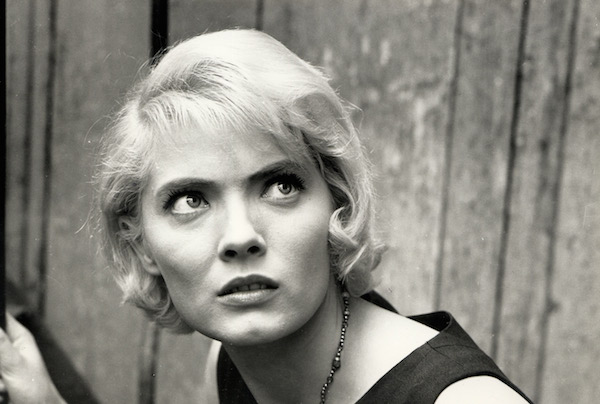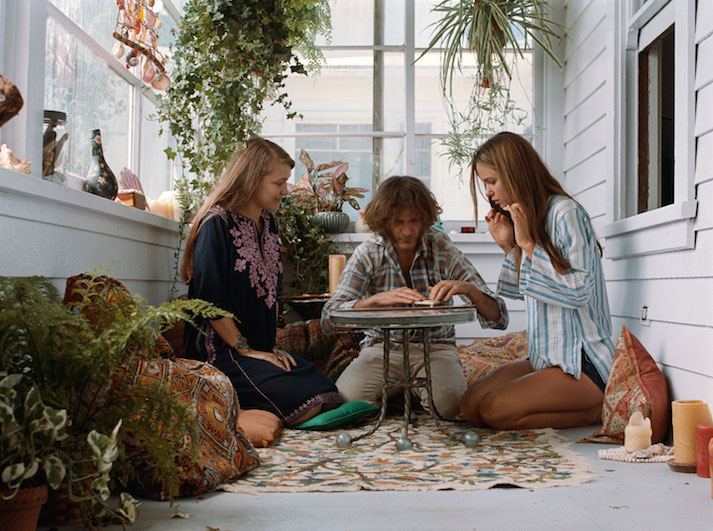At night, as my head sinks into my pillow, I often wonder if I’d be able to recognize love when it appears in my life. I usually arrive at the conclusion that I have, on countless occasions, obliviously waltzed right past it with a big, dumb grin on my face–and then I start thinking about Agnès Varda’s 1962 film, Clèo from 5 to 7.
There are a handful of terrific films in history that successfully portray action in real time, but none of them quite as precise, as meticulously committed to capturing real human experience, as Cleo from 5 to 7. After watching the film I feel like I’ve just spent 90 minutes marching down the Left Bank of Paris, soaking in the energy of the early sixties alongside our protagonist. Breaking away from conventional film technique, in which narrative rhythm and drama is manufactured through the manipulation of space and time, Varda embraces the subjectivity of her lead, ensuring the viewer experiences every moment the way Clèo (Corrinne Marchand) does, in real time. Every second builds on the last, adding tension, and before the end I’m totally invested in Clèo. Varda masterfully deploys the real-time structure so as to transform a story that, constructed in almost any other way, would feel utterly tedious into a gripping character study. Instead of just a vain, narcissistic, and shallow singer, Clèo changes into a relatable young woman whom we care about immensely. As Clèo learns to recognize love, what’s truly significant or insignificant in her life, we learn to appreciate and love her in return, and walk away reevaluating our own lives.
The plot is concentrated entirely within this 90-minute span of Clèo’s life. In France, the hours of 5 to 7 are considered the hours when lovers meet, but Clèo, a normally carefree young woman, is in dire straits. Clèo is disconsolate, awaiting the results of a medical test that will determine whether or not she has stomach cancer. The slice of her life we experience is the 90 minutes prior to her hospital visit, the moment of truth.
As I’ve mentioned, this is not merely a formalist exercise of cinematic virtuosity. Varda once commented on this film, calling it a “portrait of a woman painted onto a documentary of Paris,” and though I agree with her assessment, I don’t think it communicates the extraordinary elegance with which the film portrays Clèo’s subjectivity. Varda not only captures the material, physical details but also the way Clèo’s mind processes them, the way her personality and mood informs her interactions with and her perception of the world around her. It is this incredible quality that makes Clèo’s behavior, much of which seems initially unremarkable or simply quotidian, so engaging. And I believe that it’s this extremely modern and subtle form of expressionism that has helped the film age so well.
Clèo’s path along the Left Bank is, geographically, straightforward; she stops for some food, goes shopping, takes a cab, stops at her place briefly for a music rehearsal, walks through a park, etc. But emotionally, as she draws nearer and nearer to the moment that may potentially signal the final stage of her life, Clèo undergoes a significant character arc without seeming–just like in real life–to have reached a distinct instant of change.
Clèo from 5 to 7 is a pure representation of life for a young Parisian woman in the early sixties, and because of this it’s easy to crown Varda as standard-bearer for feminist cinema. She herself has rejected this title but, either way, Clèo is ahead of its time. Many critics have recently taken a new stance toward, calling it, for example, a strikingly complex instance of “postfeminism” in cinema.
Of course, for a lead character, Clèo certainly doesn’t seem well equipped to garner sympathy from the viewer, at least not at first. She is immature, shallow, vain, petulant, and, if not for her stunning beauty, would likely alienate most of the people around her. She seems detached from her small but vaguely promising career as a pop singer and she is also privileged–financially supported by her older lover who makes no demands of her. She lives in a nice apartment and can afford numerous luxuries.
Everything about Clèo is potentially repellent, but in the end compassion wins out. Clèo’s plight, and Corrine Marchand’s tremendously sensitive performance are irresistible. Watching Clèo re-evaluate her life, her possessions, and relationships is immensely gratifying, and as she matures she’s able to start confronting her more unsavory characteristics. Few films pull off this type of character transition with such grace.
Some may find it surprising, then, to learn that Agnès Varda was not trained as a filmmaker or film critic, like most directors of the French New Wave, but as a photographer. Her films bear this distinction. Of all the major directors in the French New Wave (Jean-Luc Godard, Francois Truffaut, Alain Resnais, Jacques Rivette, Eric Rohmer, Claude Chabrol, Louis Malle, Chris Marker, and Jacques Demy–Varda’s husband), Varda seems to produce the work least influenced by the inherent smugness of being a film snob, a particular smugness often required to make a film that changes cinematic history. Though she’s displayed total mastery of cinematic form throughout her career, Varda’s primary concern has always seemed to be the characters. Her formal experiments occur within the boundaries of her narrative structure, and therefore contribute to the complexity and richness of the story. It’s all about Clèo.
That is the source of the connection I feel to Clèo, why I so often recall this film when reflecting on my own life. Clèo, like all of us, has her own concerns, her own fears and desires. Her true struggle throughout the film is learning how to keep these concerns from dominating her, from dictating her behavior and emotions. When she steps back from herself she gains perspective on the world around her, and although she begins to recognize that she’s unhappy, that she’s been oblivious to what’s truly important to her, everything remains okay. She’s also beginning to recognize how many opportunities there are for her to find the happiness and comfort she seeks. She’s learning how to truly interact with and love other people, and it’s amazing to watch.


Recent Comments